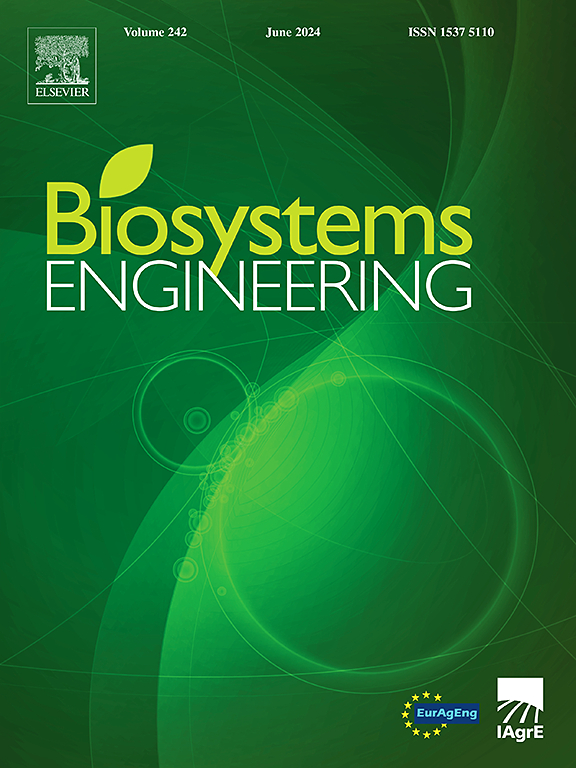Evaluating the influence of straight-plain types of rotary tiller blades with various edge curves on maize residue using DEM
IF 4.4
1区 农林科学
Q1 AGRICULTURAL ENGINEERING
引用次数: 0
Abstract
In no-tillage and minimum tillage systems, the abundance of crop residues and stubble left on the soil surface poses considerable challenges in seedbed preparation and residue handling for seeders in maize-wheat rotations. This study utilised the Discrete Element Method (DEM) to develop models illustrating the interactions between plain-straight blades featuring three edge-curves (Archimedean spiral, sinusoidal-exponential spiral, and logarithmic spiral) and maize residues, encompassing stubble and straw. Simulation experiments were employed to evaluate the soil disturbance, operational resistance, torque requirements, and residue-cutting efficiency of these various blade types at four initial static slide-cutting angles (ISSCAs: 35°, 45°, 55°, 65°). The simulation results exhibited an error of <7.5% compared to actual measurements of straw bending properties and soil cone index. The results showed that blade length, curvature, and dynamic slide-cutting angle range increased with higher ISSCA values. The elevation in slide-cutting angles notably enhanced the slide-cutting performance of the blade, leading to diminished torque requirements and draft forces within specific ISSCA ranges while improving residue-cutting efficiency. The stubble-cutting revealed more obvious soil disturbance than straw-cutting due to the adhesion between roots and soil. Notably, all three blade types exhibited increased vertical force and amplified soil disturbance area at 65° ISSCA during stubble cutting, primarily influenced by blade length. The Archimedean spiral blade demonstrated superior residue-cutting efficiency at 55° ISSCA while exhibiting reduced torque demands, operational resistance, and soil disturbance among all treatments. The findings help optimise the structure of plain-straight blades and field residue management.

利用DEM评价不同边缘曲线直平型旋耕机叶片对玉米残茬的影响
在免耕和少耕制度下,土壤表面留下的大量作物残茬和残茬给玉米-小麦轮作中播种者的苗床准备和残茬处理带来了相当大的挑战。本研究利用离散元法(DEM)建立了具有三条边缘曲线(阿基米德螺旋、正弦指数螺旋和对数螺旋)的平直叶片与玉米残茬(包括残茬和秸秆)之间相互作用的模型。通过模拟实验,评估了不同类型叶片在4个初始静态滑切角度(ISSCAs: 35°、45°、55°、65°)下的土壤扰动、操作阻力、扭矩要求和残割效率。与秸秆弯曲特性和土壤锥指数的实际测量值相比,模拟结果的误差为7.5%。结果表明:叶片长度、曲率和动态滑切角范围随ISSCA值的增大而增大;滑切角度的提升显著提高了叶片的滑切性能,在特定的ISSCA范围内降低了扭矩要求和牵引力,同时提高了残割效率。割茬比割秆表现出更明显的土壤扰动,这是由于根系与土壤的黏附作用。值得注意的是,在65°ISSCA条件下,三种叶片类型在割茬过程中均表现出垂直力增大和土壤扰动面积增大的趋势,这主要受叶片长度的影响。阿基米德螺旋叶片在55°ISSCA下表现出优异的残留物切割效率,同时在所有处理中表现出更低的扭矩需求、操作阻力和土壤干扰。研究结果有助于优化平直叶片结构和田间剩余物管理。
本文章由计算机程序翻译,如有差异,请以英文原文为准。
求助全文
约1分钟内获得全文
求助全文
来源期刊

Biosystems Engineering
农林科学-农业工程
CiteScore
10.60
自引率
7.80%
发文量
239
审稿时长
53 days
期刊介绍:
Biosystems Engineering publishes research in engineering and the physical sciences that represent advances in understanding or modelling of the performance of biological systems for sustainable developments in land use and the environment, agriculture and amenity, bioproduction processes and the food chain. The subject matter of the journal reflects the wide range and interdisciplinary nature of research in engineering for biological systems.
 求助内容:
求助内容: 应助结果提醒方式:
应助结果提醒方式:


